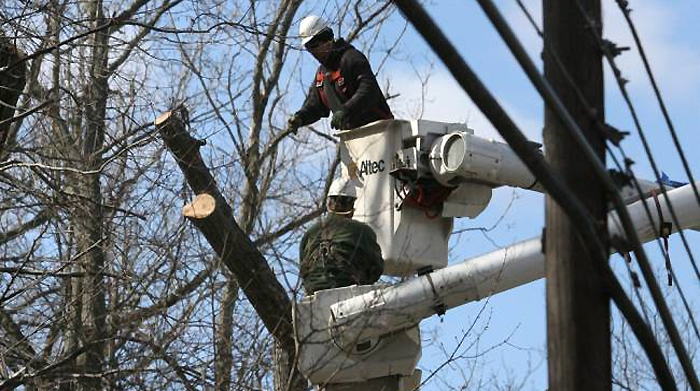The Unique Challenges of Ice Storms, Part 1

Like oil and water, ice and power reliability do not mix. Even as little as a quarter-inch of ice accumulation can cause widespread power outages (not to mention, general mayhem). For example, a December 2013 ice storm in Michigan resulted in approximately 40% of the Lansing Board of Water & Light’s (BWL) customers losing power. Another December 2013 ice storm resulted in 57% (416,000) of Toronto Hydro’s customers losing power. In February 2014, an ice storm knocked out power for 950,000 residents throughout southeastern Pennsylvania. The list goes on and on, but you get the point.
One of the biggest problems with ice storms is that the ice buildup causes tree limbs to fall and come into contact with overhead lines, causing faults or tearing them down and damaging poles, transformers, and other equipment. Ice buildup on the lines themselves, although not damaging itself, can add up to 200 pounds of weight which makes them more prone to breakage from falling limbs. Additionally, sometimes ice storms can be accompanied by snow and wind which increases tree damage and further complicates matters. And if the trees still have foliage, as they say in New Jersey – fuggedaboudit.
Obviously there is a direct correlation between the number of trees in close proximity to power lines and the number of outages that will occur as a result of ice storms. Making matters worse is the fact that the damage does not necessarily end with the storm – branches may continue to break and fall for several days after the storm has passed. And melting ice presents its own risks, as bent trees weighed down with ice spring back up (bounce back), potentially taking out more power lines. This is why developing and executing an effective right-of-way (ROW) tree trimming / vegetation management plan is one of the most important thing utilities can to do maximize system resiliency during ice storms.
Tree Trimming and Municipal Ordinances
The goal of tree trimming is to create a large enough clear area around power lines to protect them from contact with vegetation, and to allow adequate access by line crews, until the next trimming cycle. Unfortunately, not all municipalities cooperate – some municipalities have adopted ordinances that limit the local utility’s tree trimming practices. Such ordinances are designed to enhance the environment and aesthetics of a city, but if improperly formulated, they can compromise utility infrastructure and reliability when ice storms occur. Therefore a proper balance must be struck between aesthetic benefits to the community and power reliability during ice storms in areas that are vulnerable to these types of weather events.
Vegetation Management Best Practices for Ice Storms
Obviously all utilities have vegetation management plans in place, and we here at Emergency Preparedness Partnerships recommend they be reviewed annually to keep them up to date and optimize their ability to minimize ice storm damage. In general, vegetation management plans should have the following characteristics:
- Effective vegetation management encompasses more than just tree trimming – for example, removing a dead or diseased tree outside an easement or ROW that poses a danger of falling onto a power line (after getting homeowner approval of course), utilizing an environmentally-friendly herbicide to control shrubs and shorter trees in ROWs and easements, and piloting technologies such as “Light Detection and Ranging” (LiDAR) systems to more efficiently identify “vegetation hot spots” and enable more targeted cutting.
- Tree trimming should occur cyclically. In most areas a 5-year cycle is adequate, but in heavily forested areas a 3-year cycle might be more appropriate. This policy means that each circuit should be inspected and cleared every 3-5 years depending on the type of line and the type and density of vegetation around each circuit. Irrespective of the cycle, some lines may be trimmed more frequently as circumstances dictate (i.e., areas with historical evidence of tree contact with power lines).
- The plan should encompass a proactive and timely communications strategy for customers, local government officials, and other external stakeholders living in or overseeing areas scheduled for vegetation management. Publishing contact info so customers can directly contact the supervisor overseeing the trimming efforts with any questions or complaints is also a good idea to help ensure that minor complaints don’t escalate into major news stories.
Summary
Snow and sub-zero temperatures are one thing, but the damage that can be caused by a major ice storm can be especially challenging – especially for utilities serving municipalities that have a lot of trees and/or restrictive vegetation management ordinances. In these cases it is imperative to make a concerted effort to continuously build relationships and regularly communicate with local government officials. Building these relationships will help ease the process of working toward a compromise if the local tree ordinances place the utility’s reliability at risk.

